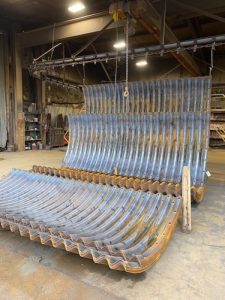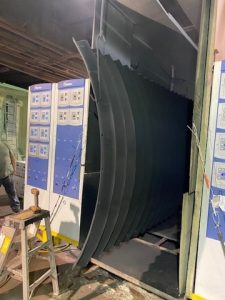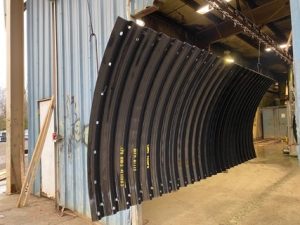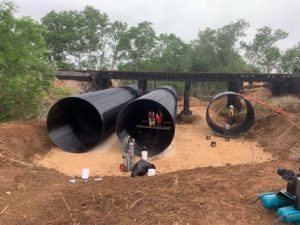By: Lane Enterprises, Inc.

Railway timber trestles were extensively used in the 19th century, making up from 1 to 3 percent of the total length of the average railroad. These trestles are a growing focus for the railways, as the 21st century is witnessing their need for replacement.
Shutting down the tracks is equivalent to shutting down the revenue stream, and the construction times associated with remove and replace projects makes these considerations unrealistic at best. As a result, the railways prefer to rehabilitate or even replace these structures in place while rail transports seamlessly continue.

The Union Pacific Bridge identified as Rockport Sub. Culvert 11.50 is a classic example of how an existing bridge can be replaced without disrupting rail operations.
The railways have a long history with corrugated steel pipe (CSP) and structural plate pipe (SPP). However, their design standards and material specifications are not always consistent with industry offerings and/or manufacturing capabilities, as would have been the case for this project if it weren’t for a timely development in 2020 virtually unknown to engineers and specifiers alike to this day.

The four-span timber trestle was targeted for removal and the objective was to accomplish this feat while keeping the rail seamlessly in service. The railway decided that three, 84-ft long, 120-inch SPP’s would be used in three of the four spans, an outside span being more realistically eliminated altogether with appropriate fill.
The decision for SPP was on target as the specifiers would have been hard-pressed for a different solution. The problem, however, is that the SPP was specified in accordance with Union Pacific standards: (1) 8 gage pipes must be polymer coated, and (2) pipes 96-inch and larger must be polymer coated. In order to meet their own standards they specified the SPP to be manufactured with polymer pre-coated steel sheet per AASHTO M246 (a CSP specification), commercially unavailable in 8 gage and a material incapable of being converted to structural plate for a host of reasons.

Unbeknownst to the designers, the industry had developed a method to provide a polymer coated steel structural plate product, the fruits of their efforts being published as an ASTM standard in 2020 with the designation ASTM A1113, Standard Specification for Corrugated Steel Structural Plate, Polymer-Coated, for Field-Bolted Pipe, Pipe-Arches, and Arches.
With a coating facility located in Carlisle, PA, Lane was intimately involved in the polymer-plate product development and uniquely poised to manufacture and coat the plate used in the bridge replacement project.

The work remaining to be done went seamlessly as hoped: structural plate pipe was field-bolted in place, exposed pipe on each side of the tracks was backfilled, and flowable fill was used beneath the tracks to complete the embedment. While the old timber trestle remains as a sort of time capsule – a buried bridge if you will – the new structure is in fact a very much visible and beautiful buried bridge.
